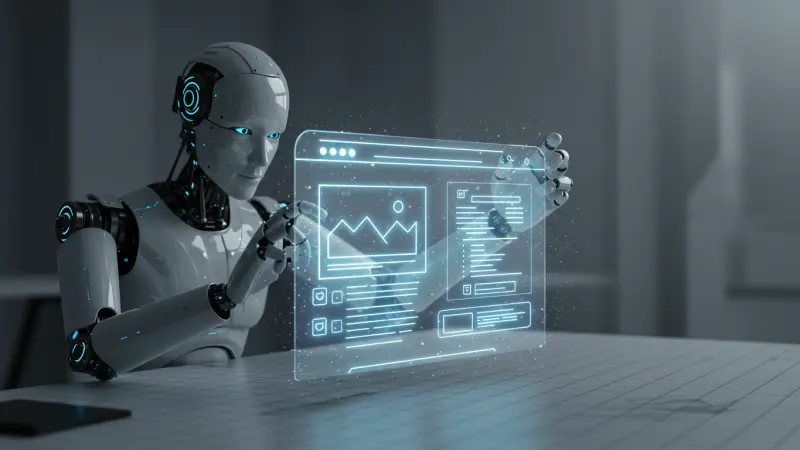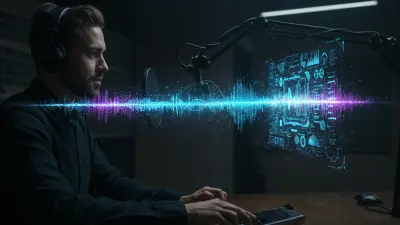From Zero to Launch: How I Built a Website Using Only AI Tools

From Zero to Launch: My Journey Building a Website with Only AI
Ever had a brilliant idea for a website but felt stopped in your tracks by the sheer scale of the task? The coding, the design, the content creation, the cost... it's a mountain of work. As someone deeply embedded in the world of AI, I started to wonder: could the mountain be moved? Could I build a complete, professional, and functional website from the initial idea to the final launch using nothing but artificial intelligence tools? I decided to find out.
This isn't just a thought experiment. It's a real-world case study of my journey, a step-by-step blueprint for anyone who wants to leverage the incredible power of AI to bring their digital vision to life. Forget needing to be a coder, a graphic designer, and a copywriter all at once. For this project, my only role was that of a director, guiding a team of specialized AIs to do the heavy lifting. Here’s how it all went down.
Step 1: Laying the Foundation with an AI Strategy Session
Every great project starts with a solid plan. Instead of a whiteboard and sticky notes, my brainstorming partner was a large language model (LLM) like ChatGPT-4. My goal was to define a viable project, understand my audience, and map out the structure of the site.
Brainstorming the Niche
I started with a broad concept: a resource for a specific hobby. I fed the AI this general idea and asked it to perform a market analysis.
My prompt looked something like this: "Act as a market research analyst. I want to build a content website for a hobby. Based on current online trends, search volume, and monetization potential, suggest 5 niche hobbies that are underserved but have a passionate community. For each, provide a potential target audience and unique angles for the content."
The AI returned a fantastic list, including 'Artisanal Bread Making for Beginners,' 'Urban Beekeeping,' and 'Custom Mechanical Keyboards.' I settled on 'Sustainable Urban Gardening,' as it felt both trendy and genuinely useful. The AI had done in minutes what would have taken me days of research.
Defining the User Persona and Sitemap
With my niche selected, I needed to understand my future visitors. I asked the AI to create a detailed user persona:
"Create a detailed user persona for a website about 'Sustainable Urban Gardening.' Call her 'Chloe.' Include her demographics, goals, pain points, and what she would look for in a website like this."
The result was a profile of a 32-year-old apartment dweller who wanted to grow her own food but felt overwhelmed by the lack of space and information. This persona, Chloe, became my north star for every subsequent decision. Finally, I had the AI map out a logical sitemap: Home, About, 'Getting Started' Guides, a Blog, and a Contact page. The blueprint was complete.
Step 2: Crafting a Visual Identity in the AI Design Studio
With a solid strategy, it was time to give my project a face. I needed a logo, a color scheme, and a general design direction. This is where AI image generators and design tools truly shine.
Generating a Logo and Brand Kit
I turned to Midjourney for initial logo concepts. My prompts were descriptive, focusing on the feeling I wanted to evoke.
Example Prompt: "Minimalist logo design for a brand called 'Urban Roots.' A single, clean line drawing that combines a city skyline with a sprouting leaf. Earthy tones, vector style, on a white background."
After a few iterations, I had a concept I loved. While AI image generators are great for ideas, I then took that concept to an AI-powered logo maker like Looka. These tools are designed to create practical brand assets. I uploaded my concept, and the AI generated a complete brand kit, including logo variations, font pairings, and a professional color palette. I had a full brand identity without opening Photoshop once.
Prototyping the User Interface
To visualize the layout before the build, I used a tool called Uizard. It has an incredible feature where you can feed it text prompts to generate UI mockups. I described my homepage based on Chloe's needs: "A clean, welcoming homepage for a gardening blog. It needs a large hero image, a headline, a call-to-action button, a section for 'Latest Guides,' and a simple footer." In seconds, I had a visual wireframe that would guide the final build.
Step 3: Populating the Site with an AI Content Team
A beautiful website is useless without compelling content. My next phase was to create all the necessary text and imagery to fill the pages I had planned.
Writing All the Website Copy
I tasked my LLM assistant (this time, I used Claude 3 for its slightly more narrative writing style) with drafting the copy for every page. The key was providing it with the right context.
My prompt for the About page: "Write the copy for the 'About Us' page for 'Urban Roots.' The tone should be passionate, encouraging, and slightly rustic. Reference our mission to help city dwellers like 'Chloe' (our user persona) connect with nature and grow their own food, no matter how small their space is. Keep paragraphs short and engaging."
Crucially, I did not just copy and paste the output. AI is an incredible starting point—a tireless junior writer. My job was to act as the senior editor, refining the text, injecting my unique voice, and ensuring every word aligned with the brand. This human-AI collaboration is where the magic happens.
Generating a Library of Blog Posts and Images
To launch with a healthy amount of content, I had the AI generate a content calendar with 10 blog post ideas, complete with SEO keywords. It then drafted each post, covering topics like "The 5 Best Vegetables to Grow on a Balcony" and "A Beginner's Guide to Composting in an Apartment."
For images, I used DALL-E 3. Instead of generic stock photos of plants, I could create hyper-specific, beautifully stylized images. Prompts like "A beautiful, photorealistic shot of a thriving basil plant in a terracotta pot on a sunny apartment windowsill, with a blurred city street visible in the background" gave me unique, high-quality visuals that made the site feel authentic and professional.
Step 4: The Main Event: Assembling the Site with an AI Builder
This was the moment of truth. I had my strategy, my design assets, and my content. Now, I needed to put it all together. For this, I turned to an AI-powered website builder. There are several great options on the market, like 10Web or Framer AI, but for this experiment, I chose Durable for its claim of building a site in under a minute.
The process was astonishingly simple:
- I entered my business type: "Urban Gardening Blog."
- I gave it the name: "Urban Roots."
- I clicked "Generate."
In about 30 seconds, a fully formed, multi-page website appeared on my screen. It had a logical structure, placeholder images, and AI-written text that was surprisingly relevant. The AI had built the entire framework, including a contact form and social media links.
My job was now to customize it. I went through section by section, replacing the placeholder content with the carefully crafted text from my LLM and the custom images from DALL-E 3. I uploaded my logo, adjusted the colors to match my brand kit, and rearranged a few sections using the intuitive drag-and-drop editor. Within a couple of hours, the generic template had transformed into *my* website.
Step 5: Preparing for Launch with an AI SEO Specialist
A website that no one can find is just a digital diary. The final step was to optimize the site for search engines. Once again, AI was my go-to consultant.
I used an AI tool to perform keyword research for each page and blog post. Then, I had my LLM assistant write unique, compelling meta titles and descriptions for each page, incorporating the target keywords naturally. I even had it generate alt text for all my images, a tedious but vital SEO task.
Many AI builders, including the one I used, automatically handle technical SEO aspects like generating a `sitemap.xml` file and a `robots.txt` file, ensuring the site is ready for Google's crawlers from day one.
Explore Hundreds of AI Tools
Ready to find the perfect tool for your needs? Browse our complete, filterable directory of the best AI software on the market.
Browse the DirectoryThe Final Verdict: Is an AI-Only Website Build Worth It?
After connecting my domain and hitting 'publish,' I took a step back. There it was: Urban Roots, a fully-fledged, beautifully designed, and content-rich website. And I hadn't written a single line of code or hired a single person. The total time from idea to launch? Under 8 hours, spread across a weekend.
So, is it worth it? The answer is a resounding yes, with a few important caveats.
The Pros:
- Incredible Speed: What would have taken weeks or months was condensed into hours.
- Massive Cost Savings: The cost of a few AI tool subscriptions is a fraction of what it would cost to hire a developer, designer, and writer.
- Accessibility: It completely removes the technical barriers to entry. If you can write a prompt, you can build a website.
The Cons:
- Customization Limits: While you can customize a lot, you don't have the granular, pixel-perfect control that custom code provides. Complex, unique functionality is still out of reach.
- The 'Human Touch' is Non-Negotiable: You cannot simply accept the AI's first draft. Your role as a curator, editor, and strategist is what elevates the final product from generic to great.
This experiment proved to me that we are in a new era of creation. AI has democratized web development. It's no longer a question of man vs. machine, but man with machine. By using these tools intelligently, anyone with a vision can now build their corner of the internet. So if you've been sitting on an idea, waiting for the right time or the right skills, maybe the right time is now, and the right skill is simply learning to ask the right questions.
About Paul Peery
Founder of Best AI Powered

